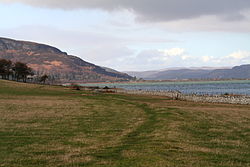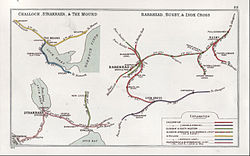- Dornoch Light Railway
-
Dornoch Light Railway 
Traces of the railway line at Skelbo.
The dark green line through this field is
the path of the railway.
A 1912 Railway Clearing House map showing
(upper left) part of the Dornoch Light Railway (blue)
and the junction at The MoundLocale Scotland Dates of operation 2 June 1902 – 31 December 1922 Successor line London Midland and Scottish Railway Track gauge 1,435 mm (4 ft 8 1⁄2 in) Length 7.75 miles Legend


 Sutherland Railway (to Golspie)
Sutherland Railway (to Golspie)





The Mound 


 Sutherland Railway (to Ardgay)
Sutherland Railway (to Ardgay)


Cambusavie Halt 


Skelbo 


Embo 


Dornoch Dornoch Light Railway was an historic railway in Scotland that ran from The Mound on the Sutherland Railway to the county town of Sutherland, Dornoch. This railway is closed.
This Railway was one of two railways in the North of Scotland built under the 1896 Light Railway Act (the other being the Wick and Lybster Railway), this allowed the line to be built to lower standards to save cost.
Contents
The route
The Railway started at a south-facing junction with the Sutherland Railway at The Mound station, departing trains turning right on a sharply falling gradient. Immediately bridging the River Fleet by a four-span viaduct the gradient brought trains to the Mound itself, actually a causeway built across the River Fleet by Thomas Telford in 1816 as part of road development in the region. Sharing the Mound with the road, the Railway crossed it at the Southern end of the causeway at a gated crossing, the first of several. The Railway then turned South-East to skirt the Southern shore of Loch Fleet coming to its first stop at Cambusavie Halt.
Throughout its existence the pace of services on the line was slow, accentuated by the need for the train to stop for the gated crossings, the guard to dismount and open the gates, the train to proceed through and stop to pick up the guard having closed the gates again. The next station was Skelbo, equipped with a goods siding, whereupon the line bore inland slightly and turned South, climbing to the fishing village of Embo, where the station was furnished with a building and a goods yard.
Following the coast of the Moray Firth on its last leg, the line passed the Royal Dornoch Golf Club before crossing the road and terminating in Dornoch. By the station was the engine shed - the line always operated on the 'one engine in steam' principle - and a goods shed. The terminus was overlooked by Dornoch Cathedral.
History
- 2 June 1902 - Opened (worked by the Highland Railway).[1]
- 1 January 1923 - Became part of the London Midland and Scottish Railway.[1]
- 13 June 1960 - Closed to all traffic.[2]
- Spring/Summer 1962 - Track lifted.
Locomotives used on the Dornoch branch needed to be carefully selected for a light axle loading, and they operated both passenger trains and pick-up freight. They were based at Helmsdale, where the running maintenance was carried out;[3] there was a small shed at Dornoch for overnight stabling.[4]
The first locomotive used on the branch was Highland Railway "Lochgorm Tank" 0-6-0T no. 56, which had been built in 1869 and rebuilt in 1896.[5] It was specially renamed Dornoch for the branch; it had previously been named Balnain.[6] This locomotive was used on the branch until at least Summer 1919.[5]
Other locomotives used at different periods included: Highland Railway 0-4-4T (BR no. 55053), which was the last Highland Railway locomotive to remain in service,[7] and BR Standard Class 2 2-6-0 no. 78052, which was based at Helmsdale from February 1957.[8]
In April 1957, ex-Great Western Railway (GWR) 0-6-0PT no. 1646 of the GWR 1600 Class was sent to Helmsdale for the Dornoch branch, and 78052 became spare, used when 1646 was unavailable.[7] A second engine of the 1600 Class, no. 1649, was sent to Helmsdale in July 1958, so no. 78052 became redundant and was sent elsewhere that September.[9]
Nos. 1646 and 1649 were later transferred to Dingwall, where they remained until both were withdrawn from service in December 1962.[10]
Connections to other lines
- Sutherland Railway at The Mound
Current operations
The line is closed.
References
Notes
- ^ a b Butt 1995, p. 81.
- ^ RAILSCOT
- ^ Walford 2003, p. 257.
- ^ Cormack & Stevenson 1988, p. 69.
- ^ a b Cormack & Stevenson 1988, p. 72.
- ^ Cormack & Stevenson 1988, p. 67.
- ^ a b Walford 2003, p. 251.
- ^ Walford 2003, pp. 245,251,261.
- ^ Walford 2003, pp. 251,261.
- ^ Rowledge 1986, p. 154.
Sources
- Awdry, Christopher (1990). Encyclopaedia of British Railway Companies. Sparkford: Patrick Stephens Ltd. ISBN 1-8526-0049-7. OCLC 19514063.
- Butt, R. V. J. (1995). The Directory of Railway Stations: details every public and private passenger station, halt, platform and stopping place, past and present (1st ed.). Sparkford: Patrick Stephens Ltd. ISBN 1-8526-0508-1. OCLC 60251199.
- Cormack, J.R.H.; Stevenson, J.L. (1988). Greenwood, William. ed. Highland Railway Locomotives Book 1: Early Days to the 'Lochs'. Locomotives of the LMS. Lincoln: RCTS. ISBN 0 901115 64 9.
- Cormack, J.R.H.; Stevenson, J.L. (1990). Greenwood, William. ed. Highland Railway Locomotives Book 2: The Drummond, Smith & Cumming Classes. Locomotives of the LMS. Lincoln: RCTS. ISBN 0 901115 72 X.
- Jowett, Alan (March 1989). Jowett's Railway Atlas of Great Britain and Ireland: From Pre-Grouping to the Present Day (1st ed.). Sparkford: Patrick Stephens Ltd. ISBN 1-8526-0086-1. OCLC 22311137.
- Rowledge, J.W.P. (1986). GWR Locomotive Allocations: First and Last Sheds 1922-1967. Newton Abbot: David & Charles. ISBN 0 7153 8820 7.
- Walford, John (2003). Taylor, R.K.. ed. A Detailed History of British Railways Standard Steam Locomotives - Volume Two: The 4-6-0 and 2-6-0 Classes. Peterborough: RCTS. ISBN 0 901115 93 2.
- RAILSCOT on Dornoch Light Railway
Major constituent railway companies of the London, Midland and Scottish Railway: Caledonian | Furness | Glasgow & South Western | Highland | Lancashire & Yorkshire | London and North Western | Midland | North Staffordshire
(Full list of constituents)Categories:- LMS constituents
- Highland Railway
- Pre-grouping British railway companies
- Early Scottish railway companies
- Railway companies established in 1896
- Railway lines opened in 1902
- Railway companies disestablished in 1923
- Standard gauge railways in Scotland
Wikimedia Foundation. 2010.
